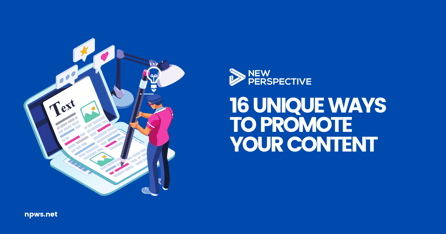Content Ideation Tips: How to Work With Sales for Killer Ideas

Writer’s block can happen to the best of us. Even after establishing a content strategy and setting goals, the words don’t always spill onto the page as effortlessly as we’d like. So where do you begin your content ideation process?
Despite its difficulties, content marketing is important. Not only does content marketing generate three times as many leads as traditional tactics, but its conversion rate is also six times higher than any other method. Which is why strategic content ideation is crucial for coming up with exciting and engaging content ideas.
So what is the best content ideation resource for marketing departments to create and visualize new content? The answer: your sales department.
What Is Sales Alignment?
Sales alignment (or “smarketing”) is the alignment between a company’s marketing and sales teams to improve efficiency, encourage collaborative efforts, and generate higher revenue. Here are some of the big benefits of making sales alignment a priority:
- Higher revenue: Aligning your sales and marketing departments helps generate 209% more revenue from marketing.
- Competitive advantage: 85% of companies with tightly aligned sales and marketing teams report that their content strategy is highly effective.
- Growth for your sales team: 70% of sales teams that are tightly aligned with marketing report increasing in size next year.
- Misalignment is fatal: Misalignment between your departments can cost your business $1 trillion each year in decreased sales productivity and wasted marketing efforts.
Marketing and sales teams have a reputation for not getting along too well. But by putting aside your differences, you will strengthen your content marketing through a better understanding of your audience and improved value proposition.
Here’s a sneak peek of what’s to come in this article:
- How to collaborate with sales to learn more about your buyer persona
- How sales calls and emails can help your content ideation process
- How to work with sales to come up with great content ideas for each stage of the funnel
- The power of organizing content marketing meetings between your marketing and sales teams
- + Tools you can use to improve the communication between both teams.
Let’s dive in.
Collaborate with Sales to Define Your Buyer Persona
Getting a clear idea of your audience is the critical first step to successful content marketing. How can you come up with engaging ideas for content if you don’t know who you’re marketing to? This is where having a clearly defined buyer persona for your company comes in.
What Is a Buyer Persona?
A buyer persona consists of a research-based profile that depicts your ideal customer. This can include their demographics (gender, age, education, etc.), their values, and the challenges they’re experiencing. Buyer personas help companies understand and empathize with their target audience so they can market their product or service effectively. Here’s why defining your buyer persona is so crucial for your brand:
- 71% of companies that exceed their revenue and lead goals have a documented buyer persona.
- Three to four buyer personas usually account for 90% of a company’s sales.
- 82% of companies using buyer personas have managed to improve their value proposition.
Define Your Buyer Persona
Salespeople are at the forefront of customer interaction—they have insights about your customers that could benefit your marketing department. They know who is a good fit for your products or services because they’re the ones closing the deals!
Before planning content, marketers should reach out to sales to gain a deeper understanding of your company’s ideal customer. Questions marketers should ask salespeople include:
- What are the most significant challenges that prospects experience in their jobs or personal life?
- Where do they get their information? Magazines, blogs, social media, Google?
- What type of content do they find helpful? White papers, case studies, YouTube videos?
- Who are their favorite influencers/thought leaders?
Working with your sales team will give marketers a good roadmap to follow when it comes to content ideation. Once you’ve gathered this information, finding relevant ideas for content marketing becomes effortless.
According to Adele Revella, founder and president of The Buyer Persona Institute:
“Without personas, you may only be guessing what content your audience wants, which means you are more likely to revert to creating content around what you know best (your products and company) instead of around the information your audience is actively seeking.”
Understanding Common Objections
“We have two ears and one mouth, so that we can listen twice as much as we speak.” – Epictetus
Coming up with brand new content ideas doesn’t have to be complicated; ask your sales team to help you directly!
Your salespeople are answering these common objections every day, so why not create content responds to these objections directly?
Listen to Sales Calls
Sales calls are authentic interactions between your customers and company. At this stage, your prospects will share their most important questions and objections. By joining in on sales calls or listening to recordings, content marketers can directly address roadblocks in the sales funnel or issues that keep cropping up.
For example, customers may highlight that they’re not sure how your return policy works or that they aren’t convinced that your product or service will work for them. Smart marketers can create and curate content to overcome these objections and help ease the sales process. Helpful content to address these objections may include:
- Blog posts: Informative blog posts on your website give prospects resources they can turn to if they are seeking additional information.
- FAQs: Adding a landing page to your website addressing your customers’ key concerns and questions will help reduce any confusion they may feel.
- Ebooks: Creating ebooks can help better educate your prospect and resolve challenges customers may experience when using the product or service.
- Case studies: Examples of previous clients who have had success with your product clear any doubts potential customers may have before making a purchase.
Bonus Tip: Read Sales Emails for Content Marketing
Another good strategy is to ask your salespeople to forward client emails to your marketing department. Customer emails often start with “How do I…?” This is perfect inspiration for blog posts, ebooks or podcasts you can create in the future for your audience! Creating content that answers those questions will help support future buyers who are wondering the same thing.
Work with Sales at Each Stage of the Buyer’s Journey
The buyer’s journey can be divided into three stages:
- Awareness Stage: The consumer becomes aware of a problem they have.
- Consideration Stage: The consumer researches potential solutions for their problem and begins to compare their options.
- Decision Stage: The customer pulls the trigger and decides to make a purchase from your brand.
Structuring your content for each stage of the buyer’s journey is crucial for many reasons. Here are the most important ones:
Prospect nurturing during the sales process: Most prospects don’t arrive on your webpage ready to buy. Many have just recently become aware of a need or problem and are just looking for information on how to fix it. With the right content, you can nurture those leads towards a conversion instead of trying to sell to them right off the bat.
Lead qualification: You want to focus on leads that are most likely to buy from you. Creating content for each stage of the buying process allows you to decide whether leads are worth pursuing before handing them over to your sales department.
Working with Sales During Content Ideation
To effectively tailor content for each stage, sales and marketing departments must combine their skills and knowledge to find engaging content ideas for their audience. Here’s how to do it:
#1. Awareness Stage
During this stage, the prospect is gathering information and they’re not yet ready to make any purchase decisions.
Talk with your sales team to ensure you really know what’s bringing people to your website. Make sure you know the answers to these questions:
- What problems does your product or service solve for customers?
- What pain points lead your prospects to your website?
- What sources—online and off—will they use to find reliable content?
- What misunderstandings are they likely to have on a topic?
By discussing these points with your sales team, it will be easy to find ideas for content that will address those concerns and show how your company can help.
#2. Consideration Stage
By the time your potential customer has reached this stage, they have a complete understanding of their needs/problem but have yet to find solutions. While they are more qualified than those in the awareness stage, they are still not ready to buy.
Firstly, you need to figure out what is most valuable to them. Secondly, you need to figure out what specific outcome prospects desire to achieve and how your company can work to help them.
To find relevant content ideas that will appeal to prospects in this stage, marketers should ask the following questions to their sales team:
- What common questions do you get from potential clients?
- Are there any topics that come up that you need content for?
- What other information would you find helpful when you’re reaching out to these leads?
- What are prospects saying about other companies that offer the same product or service that we do?
#3. Decision Stage
When prospects enter this stage, they are finally ready to make a purchasing decision. They are weighing multiple options in the hopes of finding the best one (hopefully, you!).
If the sales team hasn’t already reached out to the prospect, this is the time to do it. A call consultation will allow sales to answer any last-minute questions prospects may have about your product or service. It will also give them additional insights about what goes through the customer’s mind when they’re about to make a purchase.
Marketing teams should ask sales to provide information from their calls, as it can be used as inspiration for content to create for prospects during the decision stage. Those common objections we talked about earlier will crop up during these calls. If your marketing creates content specifically targeting those objections, your sales team can simply share that content with your prospect to address their concerns.
Organize Weekly Meetings Between Your Marketing and Sales Departments
Organizing weekly meetings between both departments is vital to identify issues and prioritize actions for your content strategy. These meetings present the perfect opportunity for content ideation, discussion, feedback, and transparency for both teams.
The goals of editorial meetings between sales and marketing include:
- Generating content ideas: Sales and marketing departments can both brainstorm ideas on the type of content they should publish next based on their agreed strategy.
- Analyzing content performance: Meetings give an opportunity to analyze what is working and what is not. Both teams can decide which type of content should be amplified and which should be stopped.
- Content approval: Members of the marketing department can show the content they plan on using to sales, who in return can help decide whether the material provides value.
- Ensuring you’re targeting the right audience: Both departments can discuss whether the audience you’re targeting is right for your company. If not, your buyer persona may need an upgrade.
How to Organize a Meeting Between Teams
#1. Appoint a leader for each department: Sales and marketing alignment involves harmonizing different points of view. This makes it essential to have someone in charge of each department who can facilitate the process.
The leaders need to have credibility in the organization. Both leaders will get to share insights their department has gathered and discuss their progression towards their content marketing goals.
#2. Create an agenda: The next step is to set up an editorial agenda to keep both departments on the same page. An editorial plan keeps both teams involved to see which content ideas are being worked on, deadlines that have to be respected, and any issues that have arisen. A suggested agenda can look like the following:
- Insights summary: An analysis on how last month’s content marketing performed.
- Brainstorming session: A session where both teams can brainstorm new ideas for their content marketing strategy.
- Upcoming topics and ideas: This can include seasonal events (Thanksgiving, Christmas, Halloween, etc.), new product/service launches, and a new direction for the next quarter’s strategy.
- Distribution: When will content be shared? Which platforms will you use?
- Strategy review: A review of the brand’s content marketing strategy and what needs to be changed/updated.
- Tips and tricks: Has anyone from either team found useful automation tools or people in your industry that are excellent sources of content or interviews?
You can use an Excel file, a Google spreadsheet, or a Trello board to create your agenda. Make sure that it’s updated after each meeting and whenever progress is made with your content.
#3. Plan and execute: The final step of a successful meeting is to summarize your main points and findings. During this phase, you should have a clear idea of what content will be published for the next month/quarter and what responsibilities every member of each team has.
Bonus: Online Tools to Improve Communication Between Teams
If you’re looking to work with sales to improve your content marketing, here are some tools you can use to facilitate communication:
- Slack: Slack is an online tool where companies can organize channels (a place for messaging, tools, and files) where teams can communicate.
- Trello: Trello comes with boards, lists, and cards that make it easy to organize and prioritize projects between teams.
- This is a video meeting and conferencing application that facilitates online communication between your teams.
Need help creating a killer content marketing plan? Contact New Perspective today to define a strategy that will generate results for your company.




